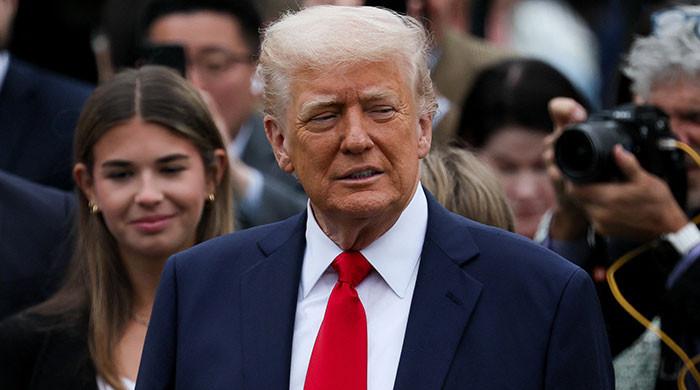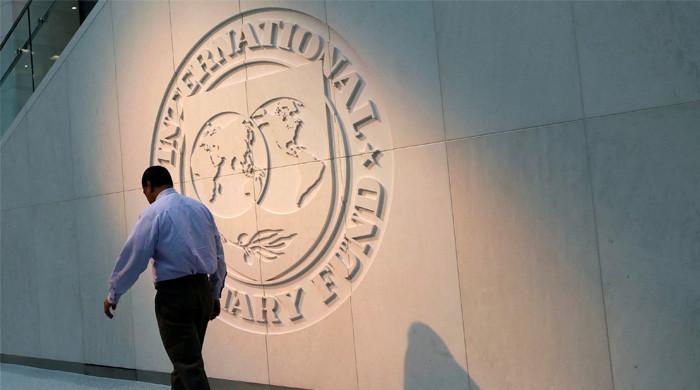The politics of Benazir Bhutto
Former prime minister's politics of "reconciliation" is a lesson for today’s politicians whether they belong to the ruling alliance or the opposition front
December 27, 2024

Arguably Pakistan’s most courageous politician, Benazir Bhutto survived three assassination attempts before being assassinated on December 27, 2007, shortly after addressing an election rally at the historic Liaquat Bagh in Rawalpindi. As former prime minister, she stood firm against terrorism and religious extremism, yet pursued reconciliation even with her staunchest political opponents as a way forward. Her politics of 'reconciliation' serves as a lesson for today's politicians, whether part of the ruling alliance or the opposition, as they have finally agreed to engage in dialogue. One can only hope that 2025 will be remembered as the year of 'reconciliation' rather than confrontation.
Benazir’s entry into politics was not accidental as even during her student life she was elected as president of Oxford University Students Union, which after her assassination dedicated 'Benazir Corner’ at the university campus which this ascribe visited during a London trip, last year. Thus, she always had that political instinct and no wonder her father noticed that and took her on his historic visit to Shimla, India in 1972, where she was interviewed by a veteran Indian journalist and author, Saeed Naqvi.
Though she always said that politics had never been her first choice as a career she turned out to be Pakistan’s most dynamic politician who despite being a woman led her party, Pakistan Peoples Party (PPP), from the front whether leading the procession or facing baton-charge or teargas before she died in a targeted suicide attack after the last election public meeting just before the general election when she was tipped to become the prime minister for the third time.
While the assassination of the first woman prime minister of the Islamic World is still an unresolved mystery and serious questions have been raised over the criminal investigation into the case and over her ‘internal security’ mechanism, a ‘million dollar’ question is why she was the constant target ever since she entered into politics.
Politics has never been easy in Pakistan, particularly for women, and Benazir Bhutto faced some of the worst kinds of criticism, and personal attacks during her years in politics to the extent that a ‘woman can’t be a prime minister in an Islamic State’. Even hurdles were created to block her thumping majority in 1988 when all was set for her to get her party's two-thirds majority. One of her staunch critics, former ISI chief late Lt-Gen Hameed Gul created an opposition alliance, the Islamic Jamohri Ittehad (IJI) and used a ‘religious card’ against her and Begum Nusrat Bhutto — Benazir's mother.
I was a witness to that political rally of the IJI in Lahore, when photographs of Begum Bhutto with former US president Gerald Ford were dropped for private aircraft in Lahore in a bid to portray the two women as Westernised ladies. Years later he himself admitted in a television interview with me that he was wrong about her.
”It is true that when she first returned to Pakistan from exile in 1986 and got a rousing reception in Lahore there was apprehension within the army establishment that if elected she would try to take revenge from some of those which she believed responsible for her father’s execution,” Gen Gull said, adding that keeping that in mind a strategy was evolved to cut to size her majority.
“However, after meeting her for the first time in Karachi, after she got elected as prime minister, I realised that I was wrong about her and she turned out to be the most patriotic Pakistani,” he stated.
Like her father, she entered into politics at a very young age and also died in her 50s like father Zulfikar Ali Bhutto but not before both Benazir and Begum Bhutto went through one of the toughest political journeys beginning with the hanging of ZAB followed by years of detention. Benazir herself described her last meeting with her father along with her mother at the ‘death cell’, on April 3, hours before he was hanged on April 4, 1979, which decades later the Supreme Court described as an ‘unjust trial and conviction,’ tantamount to ‘judicial murder’.
“It was one of the most traumatic experiences of my life," she told me in an interview years later, adding that her father gave her the courage to fight against dictators like Gen Zia ul Haq.
Benazir first became the target when she was first arrested and kept at Sukkur prison. She was put in a cell which was very vulnerable for male prisoners and jail officials, and it was an attempt to humiliate her.
When she returned from exile on 10 April 1986 she was received by nearly half a million people but that historic reception didn’t go well in powerful circles, and it was followed by verbal and abusive attacks from the pro-establishment politicians in a public meeting.
But, Benazir Bhutto was a master in handling such a situation, and she never replied to such personal attacks on her, being a woman as her vision of politics was much bigger. Even in the early 80s, just a year after ZAB’s hanging, Benazir went for a broader political alliance even with those she and particularly her mother Begum Bhutto suspected to have a role and support in Bhutto’s execution. This led to a historic alliance called, Movement for Restoration of Democracy (MRD) in 1980. This laid the foundation of her politics of ‘reconciliation’, which she continued to follow till her death.
She always distanced herself from politics of violence and terrorism and her biggest test came when in February 1981, a PIA aircraft was hijacked by some PPP activists and owned by none other than her brother, Mir Murtaza Bhutto, who was unfortunately killed by police in what officially been described as ‘encounter’ near Bhutto’s historic house 70 Clifton on September 20, 1996, when Benazir was the prime minister.
Benazir not only condemned the hijacking but described it as an attempt to sabotage the MRD and she was not all that wrong as the immediate fallout of the hijacking was that one of the parties in the alliance, Muslim Conference of Azad Kashmir of Sardar Abdul Qayyum quit the MRD. However, the alliance launched the historic movement against martial law and the alliance remained intact till 1988 and played a historic role in weakening the powerful Zia as after the the MRD 1983 movement, Zia first held a referendum to get legitimacy followed by holding non-party based elections.
Benazir faced another toughest challenge in her own stronghold Sindh and tried to bridge the gap between urban and rural Sindh, particularly after the Hyderabad massacre in which nearly 150 people were killed and in reaction over 100 were killed in Karachi. All this led to complete political polarisation and the result of the 1988 elections was a clear reflection of this urban-rural divide as the rural Sindh voted for PPP en-bloc while urban voters voted for Muttahida Qaumi Movement (MQM).
However, despite having a two-thirds majority Benazir Bhutto invited the MQM to join hands with the PPP and the two parties signed an accord and share in power. But, almost eight months later a conspiracy was hatched to overthrow the BB’s government and she herself blamed the then establishment for using the MQM in a vote of no confidence against her, which though was defeated but her government was finally dismissed on August 6, 1990.
Her politics of reconciliation led to another historic agreement and this time with her staunch political opponent former premier Nawaz Sharif when both were barred from contesting elections in 2002 by former military ruler General Pervez Musharraf. Both of them were in exile and finally, in 2006, they signed the historic ‘Charter of Democracy (COD)'.
Despite her ‘Politics of Reconciliation’ she was very firm on her resolution in the fight against terrorism and extremism and in 1993, as a consequence an attempt was made on her life when a bomb was planted near Bilawal House Chowrangi but an hour before her motorcade about to leave bomb disposal squad found a bomb was found.
Only in 2007, three attempts were made first, on October 18, when she arrived at the Karachi airport to lead the election campaign. Two suicide bombers exploded in a bid to kill her exploded themselves, killing nearly 100 people and causing injuries to 200. The next morning she visited the injured and families of those killed which clearly showed her courage and resolve against terrorism.
The second attempt was foiled in Peshawar, when two suspects were caught near her car during the rally and later confessed that they were assigned the job of killing her.
Days before her final public meeting Benazir Bhutto was informed by none other than the top intelligence officers about the danger to her life. Former ISI DG personally met her at Zardari House in Islamabad and informed her about the specific security threat to her life. On the morning of December 27, she had a breakfast meeting with ex-Afghan president Hamid Karzai and he too confirmed the threat to her life on the basis of Afghan intelligence. However, it is still a mystery whether her own chief security adviser and former interior minister late Rehman Malik also advised her not to Liaquat Bagh or not.
There was a serious security lapse as the security plan was never followed and despite the decision that no one other than Benazir Bhutto’s own security personnel would be allowed near the stage nor people would be allowed near the security gate, she was surrounded by people as she came down after the meeting which ultimately resulted in the fatal attack.
Investigation into her case also raised many questions including washout or cleaning up of the crime scene. Benazir’s personal mobile remains missing for almost a year, according to one of the members of the Joint Investigation Team, former SSP Rao Anwar. “I did not sign the JIT report as the investigation was supposed to start with the chief security officer who also kept her mobile for nearly a year. All this made the case most suspicious,” Anwar told this scribe. However, Malik at that time completely rejected all allegations against him and blamed that she was killed by militants.
Whether it was a coincidence or a surprise, when I met Malik late at night on December 27 at a local hotel in Karachi, I was taken aback and I asked: ”How come you are here and at this time?"
He said,” I am going to Dubai and will come with Zardari Sb to Ghari Khuda Bux.”
In the death of Benazir Bhutto, Pakistan lost a powerful and courageous politician with whom one can have different views agree or disagree but the general consensus about her even among her political opponents is that she always stood for ‘reconciliation’ and that one lesson can be the way forward even today.
The writer is an analyst and columnist for GEO, The News, and Jang. X: @MazharAbbasGEO
Disclaimer: The viewpoints expressed in this piece are the writer's own and don't necessarily reflect Geo.tv's editorial policy.











